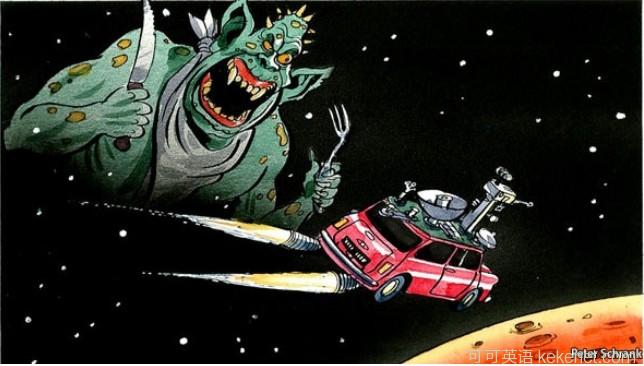(单词翻译:单击)

Science and Technolgy
科技
Mars exploration
火星探测
How to land a Mini on Mars
"迷你"漫游车如何登陆火星
The biggest and fanciest Mars rover so far will soon blast off from Florida
迄今为止最大和最新奇的火星探测器即将于佛罗里达州发射升空
EARTH excepted, the most probed and prodded planet in the solar system is Mars. Besides the assortment of craft that have flown by it or gone into orbit around it, three robotic buggies equipped with cameras and scientific instruments have roamed the Martian surface on behalf of NASA, America's space agency, since 1997.
在地球以外的太阳系内,人类探测和接触次数最多的星球要算火星了。除了飞越火星或进入其轨道运行的花样繁多的航天器之外,美国宇航局自1997年以来已有三辆机器人漫游车登陆火星,它们搭载着照相机及各种科学仪器,一直在火星上行驶漫游。
If all goes according to plan, they will soon be joined by a fourth. On November 26th a new rover, Curiosity, will ascend from Cape Canaveral. If it gets there in one piece, it will examine the climate and geology of Mars and look for any signs of life that might have arisen.
如果一切按计划进行,火星将很快迎来它们的第四个兄弟---"好奇"号火星探测器,它将于11月26日在卡纳维拉尔角发射升空。"好奇"号一旦安全着陆,将会对火星展开气候及地理环境检测,并寻找可能已经存在的生命迹象。
The first of NASA's rovers, Sojourner, which reached Mars in 1997, was 65cm long and weighed (on Earth, where the gravitational pull is 2? times Mars's) 10kg. Spirit and Opportunity, its twin successors, were larger, at 1.6 metres and 170kg. Curiosity, by comparison, is a monster. At 3 metres and 900kg it is the size of a small car. It also uses different technology. The other three rovers were powered by solar panels. Curiosity is powered by plutonium. (Not a full-scale reactor, but a generator that turns the heat of radioactive decay into electrical energy.) This brings three advantages. First, it allows Curiosity to carry more power-hungry scientific instruments than previous rovers. Second, it permits the rover to work through the Martian winter. Third, it avoids the problem of dust accumulating on the solar panels, which gradually sapped the strength of its predecessors.
美国宇航局第一个火星探测器"索杰纳"号于1997年到达火星,该探测器长65厘米,重10公斤(地球引力是火星的2.5倍)。随后到达的是"双子"火星探测器"勇气"号及"机遇"号,它们体积比"索杰纳"号稍大,长1.6米,重170公斤。与前三者相比,身长3米,重达900公斤,小汽车般大小的"好奇"号可算是个庞然大物了,而且它采用了不同的技术。前三个探测器由太阳能电池板提供能量,而"好奇"号采用核动力"钵"供能。(它不是完整的反应堆,而是具备将放射性衰变转换成电能的发电机)。采用核动力有三个好处。第一,它允许携带更高能耗的科学仪器;第二,它能保证"好奇"号在火星的冬季环境下工作。第三,它克服了太阳能电池板由于蒙尘而使前者漫游车电力逐渐下降的缺点。
Curiosity's size makes getting it safely onto the Martian surface tricky. Previous rovers have deployed parachutes to slow their descents, and have then crashed into the ground using airbags to cushion their impacts. Curiosity is too massive for that approach to work. Instead, NASA hopes to deposit it on Mars using a contraption it has dubbed a skycrane.
"好奇"号体积庞大,这使其安全着陆火星的工作变得十分棘手。之前的漫游车的下落过程采用降落伞减速,并采用气袋来缓冲撞击地面造成的冲击。但这种方法对于体积庞大的"好奇"号却不适用。美国宇航局意图采用一个设计精巧的"空中起重机"使"好奇"号安全着陆火星。
As with the other rovers, Curiosity's mother ship will rely on heat shields and air-resistance, and then on a parachute, to slow its arrival. But at an altitude of 1.6km a specially designed descent stage bearing the rover will drop away from this vehicle. The descent stage has eight rocket motors on its corners. These will slow its fall to a relatively sedate 0.75 metres a second. When it is about 20 metres above the surface, the rover will be lowered from it on wires and deposited gently onto the Martian landscape. The cables will then be cut with explosives, the descent stage will fly off and crash land elsewhere, and Curiosity will begin its mission.
与其它火星漫游车相同,"好奇"号运载船也依靠防热罩,空气阻力及降落伞实现减速到达。但不同的是,在到达距火星地表1600米的高空时,经过特殊设计并承载着漫游车的下降段将会脱离运载船。下降段底部四周装有8个火箭发动机,能使下降速度达到每秒0.75米相对缓慢的速度。在距离地面20米时,下降段用线缆将漫游车向下悬吊直至缓慢放置到火星表面。然后线缆引爆切断连接,下降段飞离漫游车在火星其它地方坠落,接下来"好奇"号就可以开始执行任务了。
That, at least, is the theory. But the skycrane has never been used before, and there is plenty else that could go wrong. Indeed, Mars has something of a reputation for destroying spacecraft. Around half the missions sent there since the first Soviet attempts in 1960 have failed to arrive. A conversation on the subject in 1964, between a journalist and John Casani, a NASA scientist, spawned the idea of a Great Galactic Ghoul, a malevolent creature that prowls the space-lanes between Earth and Mars, dining on unfortunate spacecraft.
但这毕竟是从理论角度而言的。"空中起重机"从未使用过,在实际中还可能出现诸多其它差错。事实上,火星也充当了不少航天器破坏者的角色。自1960年前苏联第一次向火星发射航天器以来,有半数左右的火星探测任务遭遇失败而无法到达火星。1964年,一名记者与美国宇航局科学家约翰·卡斯尼对此问题曾有过探讨,他们构想出一种邪恶的生物——银河系食尸鬼,它穿梭于地球与火星之间,运气不佳的航天器就会变成它的口中之食。
The ghoul's latest victim appears to have been Phobos-Grunt, an ambitious Russian mission that was intended to return to Earth with a rock sample from Phobos, the larger of Mars's moons. The Russian space agency's engineers lost contact with it soon after its launch on November 8th. Limited contact had been re-established as The Economist went to press, but it is not clear whether the mission can be salvaged. NASA's engineers, rationalists though they be, will be keeping their fingers crossed on Saturday, and hoping that the ghoul's appetite has thus been sated, and that it will leave Curiosity alone.
最近沦为食尸鬼牺牲品的可能是俄罗斯的"福布斯-土壤"号探测器。俄罗斯此项探测任务雄心勃勃,准备让探测器从"福布斯"(火星的一颗较大卫星)上取回一块岩石样本。该探测器于11月8日发射,但俄罗斯航天局工程师们很快便与其失去了联系。截至本期《经济学人》刊印之时,俄罗斯方面已与探测器重建了一些联系,但该项任务能否挽回尚未可知。尽管美国宇航局的工程师们都是理性之人,但他们也祈祷周六的发射会给他们带来些好运气,希望届时"食尸鬼"已经酒足饭饱,不会找"好奇"号的麻烦。


